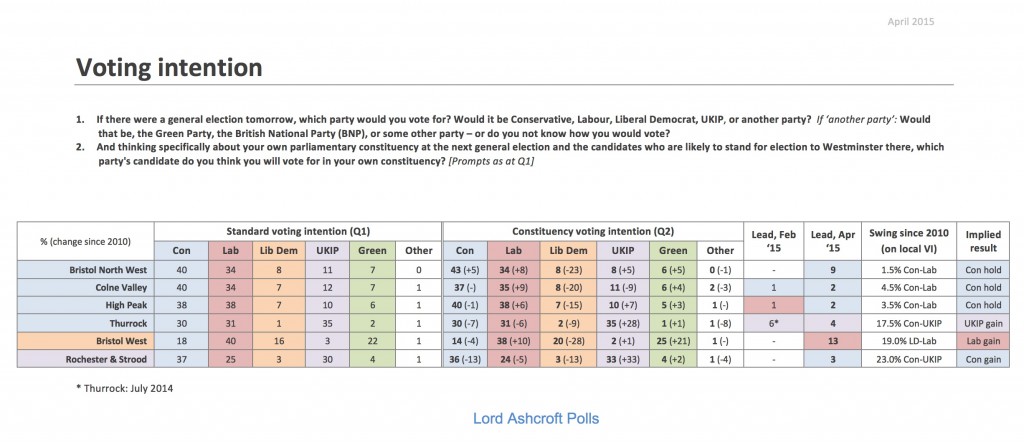My latest battleground polling I have looked at six seats, three of which I have not surveyed before.
In Bristol North West, Charlotte Leslie is well ahead in the seat she won for the Conservatives in 2010 in a three-way fight with the Liberal Democrats. Elsewhere in the city, the Green Party has been heavily targeting Bristol West, a seat the Lib Dems won in 2010 with a 20-point majority over Labour. I found the Greens in second place with a 25% vote share, with more voters attracted from the Lib Dems than from any other party. This, combined with the fact nearly three in ten 2010 Lib Dems have switched straight to Labour, would be enough for Labour to take the seat with a swing of 19% if the result were repeated on 7 May. The Lib Dems are in third even though 70% said they had received literature, direct mail, visits or phone calls from them – more than from any other party in the seat.
Most arrestingly in this set of results, I found the Tories on course to take back Rochester & Strood. There was a hint that such a result might be possible when Ipolled the seat before the by-election last November that gave UKIP their second elected MP. Uncannily, 36% of voters in the constituency said at that time that they would probably vote Conservative at the general election, exactly the proportion that said the same in my new poll, while less than three quarters of UKIP by-election voters said they expected to stay with the party. A majority of voters in the seat said they wanted to see the Conservatives in government, including 37% who wanted an overall Tory majority, and 63% said they preferred Cameron to Miliband – suggesting many are treating the by-election and the general election as very separate exercises.
Notably, though, the Tories’ seven point lead in the standard voting intention question narrows to three – well within the margin of error – when respondents were asked to think about their own constituency and the candidates likely to stand there. The ground war also looks very closely fought, with more than three quarters saying they had heard locally from from both UKIP and the Tories.
UKIP is currently doing better in its target of Thurrock, where the party’s four-point lead over Labour is comparable to the six-point advantage for the party I found last July. However, the three leading parties are within five points of each other.
Elsewhere I found a two-point Conservative advantage in both Colne Valley, up from one point in February, and in High Peak, where I found a one-point Labour lead two months ago – though statistically there remains nothing to choose between the two parties or the two results.
It is hard to draw conclusions from a small selection of such diverse seats, but the Conservatives will be hearted that they are holding their own in the two where they are in a straight fight with Labour. I found the Tory vote share unchanged since 1997 in Colne Valley, and down by a single point in High Peak. This is despite the fact that voters continue to report higher local contact rates from Labour than the Conservatives, as elsewhere on the battleground.
As ever, these surveys remain snapshots, not predictions. Further constituency polls to add to our understanding of the battleground are in the field and will be released early next week – why not sign up for news alerts to get the results straight to your inbox.

No comments:
Post a Comment
Comment is open to all feel free to link to this blog.